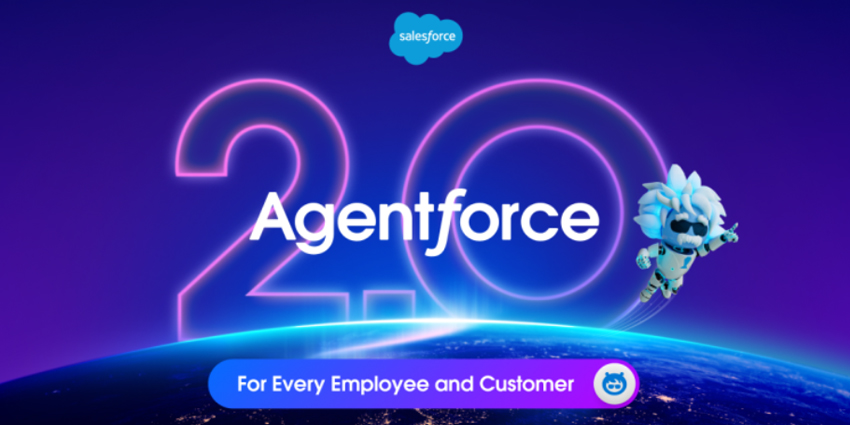Salesforce Agentforce is here, and it’s ready to revolutionize how companies create and use custom bots. Made “generally available” for Salesforce users in October 2024, Agentforce is a new layer on the Salesforce platform that allows companies to create, customize, and deploy AI agents.
Salesforce isn’t the first company to enter the “Agentic AI” ring. Google introduced new tools for building autonomous agents on the Vertex AI platform when it revealed the first model in the “Gemini 2.0 family” at the end of 2024. Microsoft is allowing users to deploy pre-built Copilot agents for various Microsoft apps and added agentic AI tools to Copilot Studio.
Even Amazon offers a range of solutions for building Agentic AI in the Amazon Bedrock ecosystem. However, Salesforce is betting on its unique technology, and the fact that Agentforce integrates seamlessly with its existing platforms, to give it an edge over the competition.
Here’s your guide to Salesforce Agentforce, how it works, and what it can do.
What is Salesforce Agentforce?
Salesforce Agentforce is a new suite of tools within the Salesforce platform that allows companies to build and deploy autonomous agents that can complete various tasks. It’s not just another way for companies to build custom generative AI chatbots and copilots.
Agentforce bots can leverage advanced reasoning capabilities to make decisions and take actions without human input. For instance, you could create an agent that can check in on an order status for a customer, make changes to an account, and even update your CRM automatically. These bots leverage large language models and machine learning, alongside unique business data.
Agentforce agents can be triggered by everything from changes in data, to pre-built automation rules, and signals made by API calls. The whole purpose of this “suite” is to make it easier for companies to create industry and task-specific agents that can accomplish more on the behalf of teams.
When Salesforce announced the “Agentforce” platform, it also introduced users to a range of “pre-built” agents. Most of these agents, including the first option (the Service Agent), focus on customer-facing tasks, like handling support and sales requests. However, Salesforce says that the potential of the platform is practically limitless.
You don’t even need to worry about the complex data integration process and custom “automation builds” necessary with other AI development platforms. Since Agentforce is already connected with all of Salesforce’s tools, companies can turn existing workflows, prompt templates, and APIs into agent actions with basically no programming knowledge.
At Dreamforce 2024, Salesforce further highlighted the flexibility of its solution, by introducing more than 10,000 agents created by Salesforce customers.
Is Salesforce Agentforce the Same as Einstein Copilot?
You’re probably already familiar with the other AI-focused solutions Salesforce has introduced over the last few years. After all, the company has been rolling out AI-powered systems for a while now – including the popular Einstein Copilot assistant.
However, Agentforce isn’t just Salesforce’s attempt to repackage it’s generative AI assistant (Einstein). You’re not just getting another AI chatbot here (albeit a highly customizable one). Agentforce is part of a wider paradigm shift in the AI landscape – focused on agentic AI.
Whereas tools like Copilot Einstein can also help users with various tasks, like addressing customer support requests and updating CRM or sales flow data, they simply “respond” to prompts from users. They don’t work independently in the background to complete tasks.
Agentforce agents, on the other hand, work autonomously, responding to changes in your customer data, or pre-set triggers, without direct human input.
According to Salesforce, the introduction of Agentforce will lead to a massive shift in the business landscape. For instance, the company believes that Agentforce agents will be able to revolutionize customer service. Already, early adopters like the Wiley company say that their autonomous agents have improved case resolution times by 40%.
How Does Salesforce Agentforce Work?
Explaining how any AI system works can be pretty complicated. That’s particularly true in the world of more “advanced” autonomous systems, where it can be difficult to follow AI thought processes. Salesforce says that the Agentforce ecosystem is a dependent on a few key things:
The Salesforce Platform and Data Cloud
As a “layer” within the Salesforce platform, Agentforce, and every bot created with the system, can access the Salesforce “data cloud.” This cloud unifies and aligns all of a company’s existing data about customers and crucial processes into a single environment. It also synchronises and updates databases in real-time, allowing agents to operate with up-to-date context and precision.
Salesforce notes that Agentforce’s access to Data Cloud improves on the investment that many companies have already made into data lakes with its Zero Copy capability. This means that Salesforce customers can connect unstructured, and structured data from external systems, without having to “copy” that data. Agentforce agents can then access all of that connected data when completing tasks and making decisions (like supporting a customer with a service request).
Advanced AI Reasoning Capabilities
Part of what makes Salesforce Agentforce special, is that the platform leverages a new solution called the “Atlas Reasoning engine” to make decisions. This engine is built on a proprietary deep learning system, which allows bots to simulate how human beings think, and plan responses to tasks.
Agents use the reasoning engine to evaluate user queries, refining them automatically for relevance and clarity. The agents than search for and review the most relevant data necessary to respond to a task, and build a “plan of execution” for what to do next. As agents begin working on a task, they learn in real-time and refine the plan further, ensuring it’s grounded in trusted data.
Streamlined Automation
The Agentforce platform seamlessly connects with the existing automation capabilities within the Salesforce platform too. It has a deep integration with MuleSoft, Salesforce Flow, and Apex, allowing customers to extend the functionality of each agent with specific workflows and actions.
Salesforce customers can take advantage of the familiar automation workflow building blocks within Salesforce to give their agents unique capabilities, without the need for advanced coding knowledge. For instance, you can quickly create agents that can search through CRM data for information about a customer when responding to a question. The agents can draw on your databases to resolve common problems, and then even update CRM records and service tickets based on the tasks it completes.
How to Use Salesforce Agentforce Agents
Currently, there are a couple of diverse ways that companies can use Salesforce Agentforce “bots.” The first option is to take advantage of one of the pre-built bots created by Salesforce. These pre-built bots are similar to the autonomous Copilot agents introduced by Microsoft at the Ignite 2024 event.
Salesforce is still adding to its “out of the box” agent collection. However, there are several options to choose from already, starting with the Service Agent, designed to manage support requests without the need for pre-programmed scenarios. Other pre-built agents include:
- SDR agents: The Sales Development Representative agents can engage with prospects 24/7, answering questions, scheduling meetings, and even addressing objections. It has access to both CRM and external data, to help it excel at lead nurturing and conversion tasks.
- Sales coach: The pre-built Sales coach agent can create and deliver personalized learning experiences to team members. It builds role-play scenarios for sales teams, using generative AI and Salesforce data.
- Buyer: The buyer agent enhances B2B buying experiences, helping shoppers to find relevant products based on their needs, and make purchases. It also allows customers to track orders via chat, or through sales portals.
- Personal shopper: Similar to the Buyer agent, this autonomous agent works on ecommerce sites and messaging apps to deliver personalized recommendations to customers. It can also assist with shopping queries.
- Merchant: The merchant agent helps ecommerce companies with everything from setting up a new website, to creating goals, and building promotional campaigns. It can write product descriptions, and provide insights into target customer groups.
- Campaign optimizer: This agent helps automate various aspects of marketing and sales campaigns. It can use AI to analyze, create, and even personalize marketing campaigns based on business goals and customer preferences.
Creating Agents with Salesforce Agentforce
For companies that want to build their own autonomous agents from scratch, Salesforce introduced various tools. The first is the simplified “Agent builder” – a low code solution that allows companies to customize out-of-the-box agents, or build new bots for specific roles.
With the agent builder, companies can use existing tools in Salesforce, like Flows, pre-built prompts, Apex, and MuleSoft APIs to design bots. You can even use natural language instructions to tell bots exactly what you want them to do, and create shareable libraries of “agent actions.”
Salesforce Agentforce also comes with a “model builder”, which is a low-code solution for creating, testing, and activating custom GPTs, AI models, and LLMs across Salesforce. Customers can use this solution to access the API keys of any LLM of their choice, and experiment with them in a secure playground. Once they’ve refined their model, users can activate them for use in a “Prompt builder”.
The Prompt Builder is Salesforce’s straightforward tool for customizing prompt templates with Data Cloud and CRM data.
Creating Agents with Salesforce Agentforce
For companies that want to build their own autonomous agents from scratch, Salesforce introduced various tools. The first is the simplified “Agent builder” – a low code solution that allows companies to customize out-of-the-box agents, or build new bots for specific roles.
With the agent builder, companies can use existing tools in Salesforce, like Flows, pre-built prompts, Apex, and MuleSoft APIs to design bots. You can even use natural language instructions to tell bots exactly what you want them to do, and create shareable libraries of “agent actions.”
Salesforce Agentforce also comes with a “model builder”, which is a low-code solution for creating, testing, and activating custom GPTs, AI models, and LLMs across Salesforce. Customers can use this solution to access the API keys of any LLM of their choice, and experiment with them in a secure playground. Once they’ve refined their model, users can activate them for use in a “Prompt builder”.
The Prompt Builder is Salesforce’s straightforward tool for customizing prompt templates with Data Cloud and CRM data. All of these tools are designed to be incredibly easy to use – even if you don’t have any prior AI-building knowledge. Even the Agent Builder has its own Agent Wizard to guide you through the initial process of customizing your own agents.
The Benefits of Salesforce Agentforce
As mentioned above, Agentforce isn’t the first user-friendly solution for building and deploying agentic AI available today. Plenty of other major AI companies are experimenting with similar solutions, from AWS, to Google, and Microsoft.
On a broad scale, the biggest thing that makes Agentforce special is the fact that it’s so deeply integrated with Salesforce’s existing ecosystem. You don’t just get full access to the Data Cloud and your CRM technology when you’re building and refining your agents. You also get support for MuleSoft for integration, automation, and API management. Plus, you can transform your Salesforce “Flow” automations into simple actions for AI bots in a matter of minutes.
Agentforce agents can also take advantage of Salesforce’s massive partner network. The company even announced the arrival of a new “Agentforce Partner Network” which allows companies to take advantage of technologies from companies like AWS, Google, Zoom, IBM, and more. Already, these partners have built a selection of agents and agent actions for Salesforce – available through the Salesforce AppExchange.
For instance, IBM is planning to give customers their own Sales Development Agent built with Agentforce, that can help businesses find new leads with insights from various connected applications and data sources. Companies can also leverage specialized actions created by partners to build their own custom gents with unique skills, capable of leveraging various forms of data and software.
Beyond all that, Salesforce Agentforce agents benefit from:
Unique Contextual Abilities
With access to Data Cloud, Salesforce isn’t just making it easier for Agentforce customers to unify and leverage their data within AI apps. The Data Cloud ecosystem comes with its own “Retrieval Augmented Generation” (RAG) functionality built-in. This allows users to easily upload files and URLs as data sources for agents, and implement advanced grounding techniques for bots.
Data Cloud and the RAG capabilities it offers makes autonomous agents within Salesforce more contextually aware, and adaptable. For instance, if a customer contacts a team through Agentforce, the built-in RAG capabilities enabled by Data Cloud can allow the bot to collect context from past support tickets, voicemails, product photos, and emails, to deliver a response.
Trust and Security Features Built-In
As AI regulations evolve, Salesforce is taking a cautious approach to protecting data with its autonomous agent solution. The Einstein Trust layer in the ecosystem protects sensitive customer data with customizable security features, and unique guardrails. For instance, there are guardrails for secure data retrieval, toxicity detection, data retention, and dynamic grounding.
There’s also an “Audit Trail” feature, which allows companies to track AI agent actions and outputs, ensuring they can guarantee their agents adhere to specific security, privacy, and governance standards. Salesforce has even released new principles and ethical controls (trust patterns), intended to boost the reliability and safety of AI agents, and reduce hallucinations.
Agents in the Flow of Work (With Slack)
The Salesforce and Slack partnership also brings unique capabilities to Salesforce Agentforce. Within Slack, companies can deploy Agentforce models for employee-facing use cases – extending the versatility of the platform. For instance, you can use pre-built agents to offer every employee access to an intelligent coach.
You can also build employee agents with Agentforce that can guide new employees through onboarding tasks, deal with troubleshooting technical tasks, and more. These agents work seamlessly within the Slack ecosystem, eliminating the need for professionals to access separate apps.
The Use Cases for Salesforce Agentforce
The Agentforce platform is still relatively new, but Salesforce has already shared plenty of “example use cases” to inspire its customers. For instance:
- Education: In education, companies can create autonomous “recruitment services” agents that offer personalized guidance to prospective students. These agents can provide learners with in-depth information about courses and schools, and even answer complex questions about majors, financial aid solutions, accommodations and more.
- Banking: In the banking landscape, autonomous Agentforce agents can oversee a range of complex manual tasks like initiating transaction disputes. For instance, an agent can retrieve information about recent transactions for an account, then ask a customer about which charges are unauthorized, before notifying merchants of disputed charges, and issuing credit.
- Healthcare: In the healthcare space, companies can create patient services agents that answers inquiries about treatment options, or helps to schedule appointments with specific physicians based on a patient’s needs. You can even enable these agents to check insurance coverage options, and generate medical history summaries.
- Manufacturing: For manufacturing companies, Agentforce makes it easy to design proactive maintenance agents that can track performance issues with equipment, machinery, vehicles, and connected devices in real-time. That agent can proactively alert customers about upcoming issues, or schedule service appointments.
- Media: In the Media space, companies can create advertising proposal agents that help sales teams respond to campaign briefs and requests. These agents can suggest the right combination of ad options, target audience profiles, and placement details to fit a campaigns specific needs and goals – then kickstart a campaign on a client’s behalf.
How Much Does Salesforce Agentforce Cost?
When it was initially announced, Salesforce Agentforce did seem prohibitively expensive to some companies. Pricing is currently based on the volume of conversations or interactions between agents and their target audience. Costs start at around $2 per conversation – which might feel pricey – after all, there are plenty of AI tools you can interact with for free.
However, it’s worth remembering that you can’t really compare an AI agent built with Agentforce to something like ChatGPT. A better way to look at the “return on investment” is to consider how much you would pay a human agent to complete the same work. For instance, how many conversations can a sales rep handle in an hour, compared to a SDR agent?
Agentforce is really only expensive if you’re not taking advantage of it correctly. If every conversation an agent has with a customer saves you more than $2 in terms of labor, training, and other costs, for instance – then the ROI of Agentforce could be excellent.
Looking Ahead with Agentforce
According to Salesforce CEO Marc Benioff, Agentforce has the potential to usher in a new era that redefines how human beings work. He believes that Agentic AI has unlimited benefits to offer companies, allowing them to augment and enhance their workforce like never before.
Obviously, we’re still in the initial stages of discovering just how beneficial Agentforce, and autonomous AI solutions like it will really be. However, there’s definitely a lot of scope here. At the very least, solutions like Agentforce will make it easier for companies to design, use, and customize more powerful AI assistants.
As demand for autonomous AI solutions grows, Salesforce is placing itself in a powerful position to become one of the top Agentic AI providers. We’ll just have to wait and see how Salesforce Agentforce stacks up against all of the similar solutions emerging in the market going forward.








